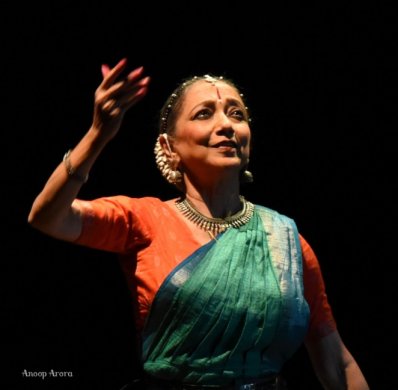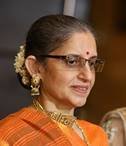
|
 |

|
 |
Leela Samson: The creative process is a response to theme and music - Shveta Arora e-mail: arorashveta1806@gmail.com Photos: Anoop Arora March 5, 2023 Last year, Bharatanatyam guru Leela Samson presented Spanda's group presentation 'Nadi' in Delhi. I asked her a few questions about the various pieces in it, the varied regional elements and rhythms.  What is the creative process like for a group choreography based on a concept or theme, as in 'Nadi'? How do you conceptualize thematic movements for multiple dancers performing in tandem? First of all, it is not possible to talk about the creative process as it is a response to the theme and the music. Analysing it is not possible. It is instinctive. The group dancers are not always dancing in tandem. Sometimes they are together in unison with each other, in tandem and sometimes not so. You have used compositions from various parts of the country and in various languages for this presentation, giving it varied regional flavours. How do you choose the music or compositions in such cases? Sometimes the music is there and one goes by instinct for the music and sahitya that lends itself to dance. If the music is not available, you have to get it composed by a musician who you think can do it justice. It is not always possible to do the right thing. Sometimes one can make a wrong choice too. One has to take the chance. What is the process of making music with such varied compositions? There is no process as such. A musician has an instinct too and we listen to the option he offers, its speed or kaala pramaanam, its cadence, the raga, the feeling, and decide to either change one or another of these or go with it. How are varied compositions strung into one theme and how is the Bharatanatyam rhythm incorporated into them? Music comes with a rhythm. What we have to see is which composition follows which one and how it all blends as a whole. Bharatanatyam does not have its own rhythm. Rhythm is universal and we have to simply go with it.  Building the choreography around each composition, how do you work on the nritta and rhythm in such varied compositions, the abhinaya, and do you add a regional tinge to the choreography as well? I have tried to give it some colour of the region in the raga chosen, in the way it is rendered and the instruments used for that composition. But the style of dance I use is Bharatanatyam. That has to be considered. In a group choreography, especially in a piece like the thillana with Madhavi Mudgal, how much work does it take on the various elements for synchronization - the positions, formations, the different agility of each dancer? The thillana in Poorvi raga which I had performed long ago with Madhavi Mudgal was for a duet and we worked it differently. This was rechoreographed for a group or ensemble.  Shveta Arora is a dance-mad writer who chronicles classical dance events in Delhi (and also those online). In 2009, she started the blog Kala Upasana at delhiculturecomment.blogspot.com, where she began posting her own writing along with photographs clicked by Anoop Arora, her husband. She's been dancing all her life as a devotee, but resumed her formal training in Kathak in her 50s and has passed her fifth year Kathak exams. Post your comments Please provide your name and email id when you use the Anonymous / blog profiles to post a comment. All appropriate comments posted with name and email id in the blog will be featured in the site. |